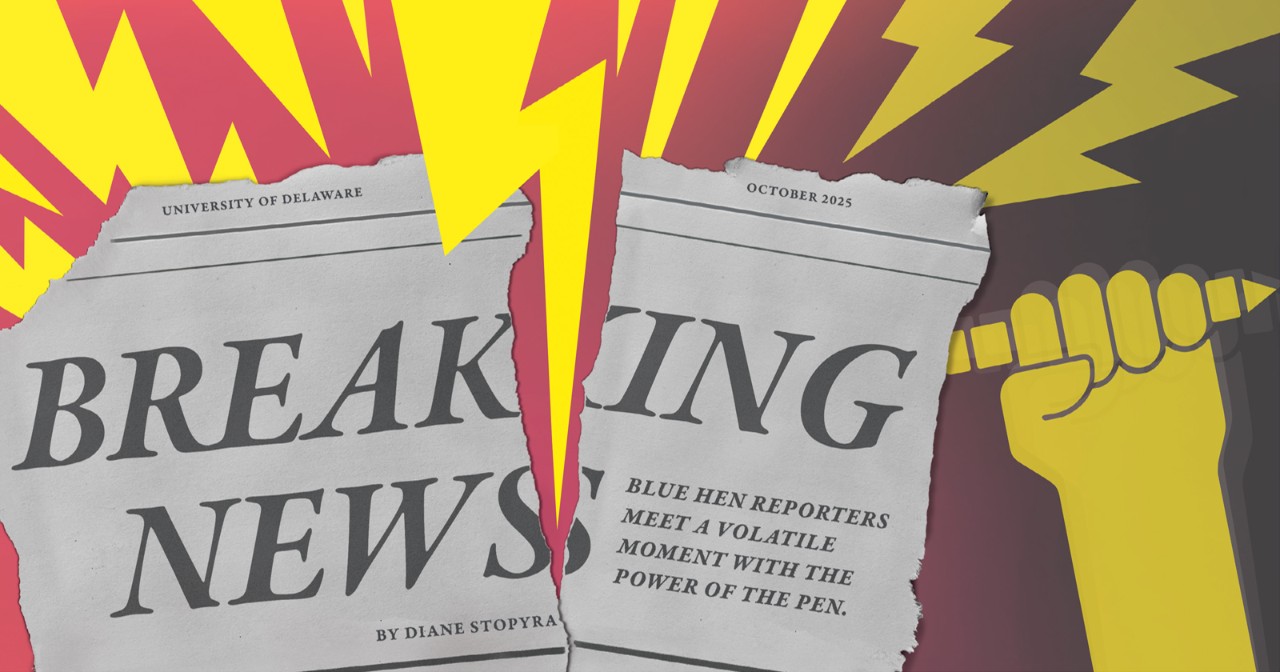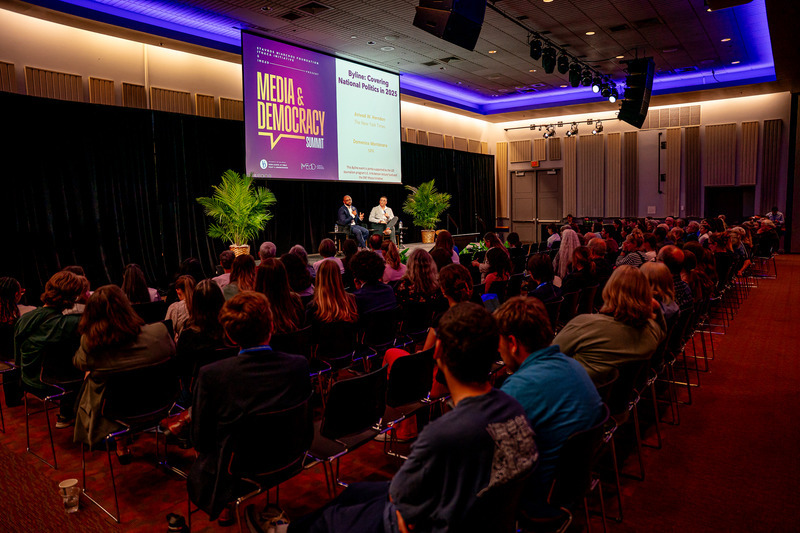


The Power of the Pen
Art by Bondé Angeline October 15, 2025
Blue Hen journalists confront a volatile moment
Of course Superman is a journalist.
Between lycra-clad heroes and ink-stained reporters, parallels abound. Both run toward danger. Both expose wrongdoing. And, perhaps most crucially, both safeguard democracy. (Or, in vintage comic-book parlance: “Truth, justice and the American way!”)
It only follows that reporters have their kryptonite, too — not a glowing green mineral, but a perfect storm of factors wreaking havoc within the global media ecosystem. While the news industry navigates treacherous terrain, UD-trained journalists are helping restore faith in a profession under fire — no capes necessary.
“Blue Hens give me hope,” said Lydia Timmins, an associate editor in UD’s journalism program and a former broadcast news reporter and producer for NBC10. “It’s not always a flashy, red-carpet lifestyle, but they’re out there every day — heads down, doing the work — dedicated to getting this right.”

The threats to the Fourth Estate are multilayered, but much of the problem can be distilled into one word: moolah. Reporting costs money, and in this digital universe, few people want to pay. (One recent study found that only 16% of Americans shell out for a news subscription, versus 22% for Netflix.) Nearly 10,000 American journalists have been laid off in the last three years — and thousands more are jumping ship.
Seeing opportunity in this grim landscape, hedge funds that value profit over journalistic integrity have swooped in. They’ve consolidated media companies and, in turn, homogenized the news. Stories are duplicated across markets. Diverse perspectives are increasingly sparse. And the resulting echo chamber? Inescapable.
“If this trajectory continues, we are headed for catastrophe,” said UD Professor Danilo Yanich, who’s been studying news consolidation for 20 years. “In a democracy, we gamble everything on an informed electorate, which you don’t have when a small number of firms control the press.”
Blue Hens give me hope. They’re out there every day—heads down, doing the work—dedicated to getting this right."
- Professor Lydia Timmins
No, it’s not the Daily Planet you need to worry about (at least not as urgently). The less considered — and arguably most important — outlets are disappearing at warp speed.
“Local news is on a downward trajectory,” said Nancy Karibjanian, Class of 1980, director of UD’s journalism program and the face of Delaware television news for more than two decades. “National stories are easier to distribute, but they don’t tell you if your sewer rates have gone up due to mismanagement. While everyone is focused on what’s happening in D.C., people are losing their power.”

As outlets fold, information vacuums are increasingly filled by internet platforms — fertile territory for disinformation. Social media algorithms are pushing users deeper into information silos. And journalists, traditionally the watchdogs of truth, are roiling in a sea of fabrication. An extremely vocal set appears happy to see them drown. (Senior NPR correspondent Domenico Montanaro, Class of 2001, divulged during an on-campus presentation that he receives death threats for his coverage of national politics.)
Public faith in traditional media has plunged to an all-time low due partly to a woeful lack of news literacy. Fringe sites are mistaken for credible sources, sensationalism for substance, and confusion reigns. Is that a journalist or an influencer? News or commentary? Confirmation of existing biases — or insights that challenge them?
The industry is culpable, too. Even respected outlets have fallen into a grave and all-too common trap: providing coverage that maps a little too neatly onto the demographics of the newsroom itself, sidelining stories — and people. This particular failing was a major topic of discussion at the University’s recent SNF Ithaca x iMEdD Media & Democracy Summit, which attracted thought leaders from across the country. During two days of discussion, scholars and journalists from The Washington Post, New York Times, NPR and other outlets gathered to advance a dialogue on the toxicity of the media environment and, crucially, where to go from here.
National stories are easier to distribute, but they don’t tell you if your sewer rates have gone up due to mismanagement. While everyone is focused on what’s happening in D.C., people are losing their power."
“I remember feeling betrayed by political journalism in 2016, by reporting that was not interested in your neighbor, not interested in context, nuance and country,” Astead W. Herndon, national politics reporter for America’s paper of record, told the crowd. “So I work to be a different type of proof point. I say, ‘You’re not talking to The New York Times; you’re talking to me. If you think there’s something we won’t print or say, try me.’”
Events like this are just one way UD is equipping a new generation of muckrakers with tools needed to meet this unprecedented moment.
Every year, nearly 150 undergraduates go through the University’s journalism program, a small-but-mighty minor that affords one-on-one attention from seasoned — and impassioned — faculty. Take Pulitzer-grant winning journalist and UD Professor Dawn Fallik — she’s been known to facilitate student coverage of UD sports for The New York Times, and she’s set up interviews with the likes of Maya Angelou and Super Bowl MVP Joe Flacco (still waiting on a response from Harry Styles).

Unlike at some larger schools, experiential learning opportunities are available for all. (Even freshmen write for The Review, one of the nation’s 10 best non-daily college newspapers, per the Associated Collegiate Press.) And because of UD’s location between three major metropolises, students regularly intern at major publications — Martha Stewart in New York, National Geographic in D.C., WHYY in Philadelphia.
For these reasons and more, graduates leave UD prepared to upend the status quo—at outlets around the globe, covering everything from the war in Gaza to scandals at city hall, they’re increasing transparency and establishing new models of journalism. Three alumni now at The Washington Post, Paul Kane, Class of 1992, Todd Frankel, Class of 1997, and David Hoffman, Class of 1975, last year won the Pulitzer Prize; Kane and Frankel for their series on the AR-15 rifle in America, and Hoffman for the rise of authoritarian regimes across the globe. The latter credits UD with “an awakening… providing a window to a world on fire and an enthusiasm that journalism could change things.”
For a new generation of Blue Hen reporters coming up the ranks, that spark is still alive — and straight off the broadsheet.
“A UD education is not just about getting a job or making money,” Timmins said. “It’s about giving back and considering other people. Inherently, that’s what journalism does.”
Up, up and away.
Contact Us
Have a UDaily story idea?
Contact us at ocm@udel.edu
Members of the press
Contact us at mediarelations@udel.edu or visit the Media Relations website

